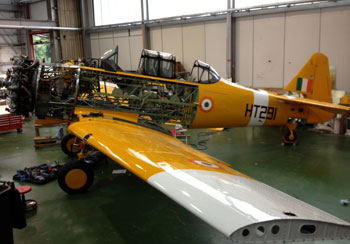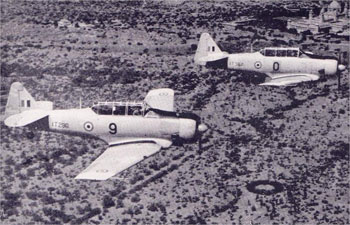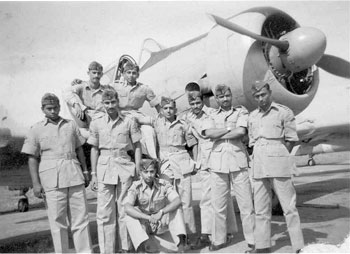INDIAN ARMED FORCES CHIEFS ON
OUR RELENTLESS AND FOCUSED PUBLISHING EFFORTS

SP Guide Publications puts forth a well compiled articulation of issues, pursuits and accomplishments of the Indian Army, over the years

I am confident that SP Guide Publications would continue to inform, inspire and influence.

My compliments to SP Guide Publications for informative and credible reportage on contemporary aerospace issues over the past six decades.
- Prime Minister witnesses 'Bharat Shakti' – a Tri-Services Firing and Manoeuvre Exercise in Pokhran, Rajasthan
- Interim Defence Budget 2024-25 — An Analysis
- Union Defence budget 2024
- Prime Minister Modi Commemorates Indian Navy Day in a Grand Ceremony
- Prime Minister Modi Flies in the LCA Tejas
- New Chapter in India-Italy Defence Ties
- Airpower beyond Boundaries
IAF's 2nd Vintage Legend to fly soon




According to the Royal Aeronautical Society, "India has a rich aviation heritage that cannot be understated and the IAF VF brings many exciting and unique aircraft to the world stage. After a 23 years absence the IAF now have the only vintage operation in India. The first IAF Vintage Flight Tigermoth is now flying and the restoration company, Reflight, is working on the Harvard aircraft. The next 4 aircraft (Spitfire, Hurricane, Tempest and Wapiti) are soon to start restoration with more aircraft planned. When the VF reaches its peak, there is no doubt India will have the most important military-run vintage operation in the world."
IAF chief Air Chief Marshal N.A.K. Browne, who retires at the end of December, is said to be extremely keen that the Harvard flies in Indian skies before he hangs up his flying boots. He had the pleasure of presiding over the Tiger Moth's display at Air Force Day 2012.
An IAF officer who visited England earlier this year to review progress on the Harvard told
The Harvard, developed and built by North American Aviation (now part of Boeing), was used by the Royal Indian Air Force starting in 1942 for advanced training ahead of World War II and and subsequently the IAF to train cadets. According to the IAF's official history, between March and December 1942, 10 aircrew schools were opened in India, and the first Harvard Is and IIs were delivered to No. 1 Flying Training School at Ambala, this school having been established to provide basic and advanced training for IAF pilots over a four-and-half month course. The aircraft was also deployed for training at Jodhpur, Hyderabad and Tambaram. The Harvard participated in the 1947-48 Kashmir operations. One flight of Harvard aircraft along with 20 Spitfires, six squadrons of Hawker Tempest fighter bombers and one squadron of Dakota transports made up the entire Royal Indian Air Force fleet at the time. When the Dakotas airlifted an infantry brigade to Srinagar, the Harvards joined the Spitfires and Tempests to provide crucially needed close air support to the Royal Indian Army.
In 1997, then Air Chief Marshal (Retd) Arjan Singh (he was made Marshal Of The Air Force in 2002) fondly remembered the Harvard, when he wrote for the IAF's Flight Safety journal: "During WWII, the air force was having trouble in getting recruits in adequate numbers for pilot and other training. To make people air-minded, a "display flight" was started with a distinguished pilot Wg Cdr Majumdar as its commanding officer; he was killed doing aerobatics in a display over Lahore. On his death, I took over and gave aerobatic displays with a single-engine Harvard aircraft."
The last Harvard flew in 1975 after which it was retired and replaced with the HAL-built HJT-16 Kiran Mk.1 trainer. It had remained in service for 33 years.
The second phase of the Vintage Flight will see Edwards supervise the restoration of the Hawker Hurricane and Tempest II, Supermarine Spitfire, and in the final phase, the final phase, the IAF's first ever aircraft, the legendary Westland Wapiti biplane. The IAF had initially also wanted to restore the Lysander fighter bomber, though a final decision is yet to be taken. The IAF handpicked the six aircraft from a canvas of nearly 40 different vintage planes that have served since the 1930s. Other aircraft that were up for initial consideration as part of the proposed Vintage Flight included the Vultee Vengeance, Percival Prentice, de Havilland Vampire and B-24 Liberator.
Mike Edwards, Chief Adviser to the Indian Air Force Vintage Flight, flew the recently restored Tigermoth at the 80th anniversary IAF parade last year. An ex-Royal Air Force pilot, currently flying Boeing 777s for British Airways and a vintage aircraft instructor, he has flown over 10,000 hours including the Vampire jet in De Havilland aviation, aerobatics for Avia and operating many other vintage aircraft; awarded the MBE in 2013 for Anglo/Indian relations and services to aviation. He will be directly associated with the entire IAF Vintage Flight programme.





